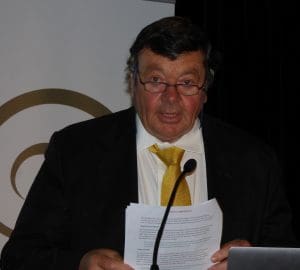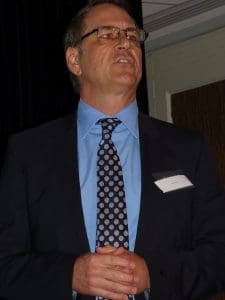
AWI chairman Wal Merriman
RAW wool would be available for 24/7 purchase via a bulletin board within a proposed Wool Exchange Portal created by Australia’s wool grower-funded body Australian Wool Innovation.
Initiating a potential radical shakeup of Australian wool marketing systems, a working group of growers, exporters, brokers, wool handler and AWI representatives has unanimously recommended the planning of a Wool Exchange Portal that could compete directly with the current physical and online wool selling systems.
The AWI board has accepted the WEP working group’s unanimous recommendation to move the Wool Exchange Portal concept to the project planning phase. Click here to get Sheep Central story links sent to your email inbox.
WEP business case by April 2017

AWI CEO Stuart McCullough
AWI chief executive officer Stuart McCullough said the working group has been asked to present to the AWI board’s April 2017 meeting a cost estimate for the WEP, a timeframe for development and a WEP company business case.
“What’s the new company look like, who owns, who runs it, who are the shareholders, what’s the board look like in terms of representation.
The AWI directors also asked for the working group to see a cost-benefit analysis, and will attach an AWI staff economist to the work group for the next stage to “shadow” its operations, he said.
“Should that go ahead, should that be approved – or maybe it won’t be – then we have green light or a red light to move to a Wool Exchange Portal.
AWI chairman Wal Merriman said the WEP would bring “a new era for growers and for transactions, and me and the board are very excited about it.”
WEP will trade wool

WEP working group chairman Will Wilson
WEP working group chairman Will Wilson told AWI’s annual general meeting last Friday the group’s vision for the WEP was for it to be “the primary and universal online entry point for wool growers to access industry information data, selling choices and trading opportunities, provided by a collaboration of wool industry stakeholders.”
“It would also provide the opportunity for wool growers to gain access to a broad range of pre-and post-trade services such as documentation, logistics and financing.”
The bulletin board allowing for 24/7 availability was part of a ‘straw man” of agreed upon ‘initial functionalities’, he said.
The others were to develop:
– And manage a nation wool grower registration system
– A central wool industry data repository
– An industry information forum and repository
– The listing and evaluation of selling options
– connectivity with selling options to allow for transactional access
He told the meeting the WEP would also provide an evaluation tool so growers could assess the “most optimal selling option.”
“The portal was also looking to connect with those selling options to allow people to link through to the actual selling options and allow for transactional access.”
He said the proposed bulletin board would be a platform that would list all tested wool, allow for that tested wool to be offered for sale, for buyers to list buying interest, and to match firm bids and offers.
After the AGM, Mr Wilson said “the first iteration” of what the WEP would be “was a bit fluffy in terms of what the functionality might be.”
“But I think, based on the meetings as part of the working group and indeed direction from AWI, was that look, be a bit bolder about this.
“The WEP will allow transactions to occur.”
WEP could compete with current physical and online auctions
Mr Wilson admitted “absolutely” that the WEP might compete with the current physical auction system and the current online wool selling systems, AuctionsPlus and Wooltrade.
“Look you know, that’s why as part of our vision we don’t want this whole process to crowd out industry innovation.
“We would rather it led to industry innovation and if there was good innovation that it led to, that the Wool Exchange Portal would be able to connect to that.”
However, Mr Wilson agreed it was still important to reinforce that the WEP would not be a threat to the status quo.
“Absolutely and I think that was what got the group over the line in the end; is to see it not as a threat, which many of them came to the table in the first meeting seeing it as, but as a potential opportunity for all their business models, whether they be wool grower, wool buyer or indeed wool broker.”
In his AGM presentation, Mr Wilson said the working group acknowledged the strengths of the existing selling system and wanted to ensure the WEP “wraps around those strengths rather than replacing them.”
He said the company running Australia’s current online wool selling platforms, AuctionsPlus, had limited resources and “really haven’t focussed on how they might more aggressively promote electronic wool welling systems.”
He said the WEP was “certainly intended to be an alternative to the existing dominant open cry auction, and maybe for different types of wool, less high quality wools or as for what AuctionsPlus Wool is most readily used now, for wool that is passed in.”
“It may create greater focus on a specific part of the market that brings buyers and sellers together more readily because of greater availability and secondly, because it is more transparent, it’s there available for everyone.
“Now the only people who could access it are those who are registered.”
WEP will not be a broker
Mr Wilson did not think the WEP would act as a broker, “but it might provide electronic issuance of (financial) guarantees, but it is envisaged that they would still be provided in the same way they are now (via brokers).”
“I point to the operation of the stock market, the role of the broker didn’t change at all in terms of the relationship with the customer, they are still the middle man – it’s just the way they deliver those services in the business models that has changed.
“You get the rise of a business like CommSec, it wouldn’t have been possible under the open cry auction system that used to be the way people would trade shares.
“I think that’s what the brokers in the room started to see, these opportunities to develop new business models, while also allowing them to more readily display their competitive advantages and their value-add in that process.”
Mr Wilson said the process of being able to see wool samples prior to sale would be enshrined in the proposed WEP.
The proposed bulletin board could include the listing of any wool tested, though not necessarily available for sale, “but all wool that’s tested goes up there,” including owner and broker details, he said.
“So all of a sudden the buying fraternity has this better view of supply of wool at any particular time.
“So if a buyer sees that, with 24/7 access they can place bids in the system as well,” Mr Wilson said.
“Now again those bids could be indicative, so you’ve got these couples if you like on either side of the dating room, who are standing in the corner, and then all of a sudden, at the flick of a button they can say ‘OK I’ve gone from indicative, to firm, to deal.’”
WEP could mean centralised wool marketing
Mr Wilson said the bulletin board would put marketing power in the hands of growers and brokers.
He hoped the WEP would allow growers to make more informed decisions about how they sell their wool and provide them with more selling options.
“For (brokers) I see the ability of looking at a more efficient way of delivering their services and a better way where they can more readily promote their specific value add to the process.
“The message I got from buyers was that were hoping it would allow them to be more efficient in the way they buy wool,” he said.
“For example it is expensive for them to have a number of people in a number of selling centres around the country, and there are often one or two rooms in which wool is sold.
“Whereas a more centralised delivery of the market will allow them to be more efficient in the way they do their work.”
Mr Wilson said told the AGM the WEP working group also recognised:
– the need to investigate providing remote buyer access to the current physical auctions;
– that greater collaboration between the AWTA, AWEX and AWI would deliver immediate benefits and for the WEP to deliver on its objectives, it would need to be a joint initiative of the institutions;
– that the role of the wool broker was a key to the success of the WEP;
– and acknowledged the strengths of the existing selling system.
“The development of a WEP wasn’t intended to replace those features, but rather to ensure that wool remains a premium product.
“The Australian wool sampling and testing regime and the ability to physically inspect wool means that many categories of Australian wool receive the highest possible prices in world markets,” he said.
“These features would not be compromised by the development of a Wool Exchange Portal, contrary to recent media announcements.”
An AWI spokesman said yesterday the Wool Exchange Portal working group’s full report was intended to be presented to the AWI board only and would not be made public.

Can AWI become any more irrelevant without the minister asking “Is this an organisation that has surpassed its used by date and should be wound up?”
Of course the WEP working group are going to agree with Stuart McCullough; he is paying them.